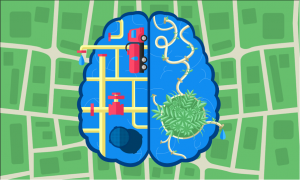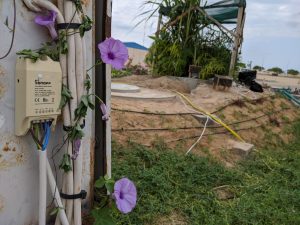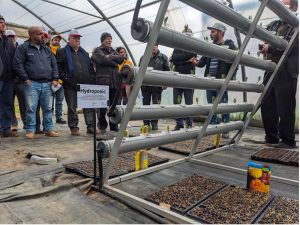In many countries, traditional waste water treatment infrastructures remain highly inefficient. The systems are centralised with kilometers of sewer pipes that are difficult to maintain and a network that is challenging to service and does not reach poorer suburbs and informal settlements. Ziad Hussami, a Lebanese social entrepreneur, decided to propose a new system: a decentralised network of remotely monitored nature-based waste water treatment facilities. He has implemented his product in various areas of Lebanon and the United Arab Emirates and is currently working with UNICEF to propose a solution that can be rapidly deployed to disaster zones and be used in refugee settlements. Mrüna is supported by our member cewas.
First, Ziad, could you please very briefly explain what Mrüna is all about?
Mrüna is a loose transliteration of the Arabic word for Resilience and that’s precisely what we strive to achieve with our product BiomWeb. BiomWeb is a holistic and rapidly deployable solution comprising innovative products & services that contribute to the capacity of communities, institutions, and businesses to adapt and thrive.
What was your motivation behind creating Mrüna, how did it all start?
When I was appointed as a Sustainability Consultant at the Dubai Expo2020 project in 2018, the site was a barren desert and my role was to achieve the CEEQUAL Sustainability Certification Credential for the project’s infrastructure. During my time there, I witnessed firsthand the amount of time, energy, and resources required to build a sewer network. Traditional wastewater utilities consist of two essential components : A centralised plant, attended by a small army of skilled operators, and a vast sewer network. Astonishingly, 80% of the construction cost is for the sewer network: including pumping stations, concrete sewer lines, precast manholes, and an army of engineers to get it accomplished. It begged the question, “Why are we spending a fortune to send precious water many kilometers away to a treatment plant, to then only bring it back in a tanker truck to irrigate the landscape?” Perhaps this strategy made sense in water rich England at the turn of the 20th century, but why do we continue to pursue the same strategy throughout the world? The experience in Dubai really got me thinking and I decided to try and propose a new solution to this problem.

In your country, Lebanon, waste water treatment is a particularly acute problem, no?
Yes, in Lebanon, the country’s largest river is overflowing with sewage, poisoning the environment and the people who eat the crops it irrigates. Donors pay a fortune to vacuum wastewater from informal settlements that have overwhelmed nearby treatment stations. To add insult to injury, most of the vacuum trucks dump their cargo in the river to save fuel, knowing full well that the treatment stations are at overcapacity anyway. NGOs, governments, and real estate developers continue to invest fortunes every year on outdated technologies and strategies. International donors have funded treatment plants that have never seen a day of operation since their ribbon cutting ceremony. Simply because carving a sanitation network up the verdant Lebanese mountainside will cost many times more than the treatment plant itself, not to mention the operating budget.
Why then are we still relying on centralised systems?
Innovation in the wastewater sector has typically been slow and other sectors have been better in putting agility at their core and implementing policies for continuous replacement and reconfiguration or upgrading of subsystems. Unfortunately, it appears, this shift has skipped the wastewater sector almost entirely. The sector just continues to rely on a model that is not much different from the cities of ancient Rome : basically, build a conduit to send the “waste” out, as rapidly and as far away as possible into the nearest water body. And, unfortunately, this also means that sewer networks never reach many of the suburban communities or address specific contextual challenges. In Lebanon and the United Arab Emirates, this one size fits all centralised sanitation strategy squanders way too many of our precious resources. In addition, it creates congestion and pollution problems: in the UAE for instance, many suburbs continue to depend on sewage trucks, which are an expensive and diesel hungry eyesore.

How does the BiomWeb approach work and look like in comparison to a centralised system?
The BiomWeb system is a decentralised, modular and small-scale approach to waste water treatment. Our design philosophy is there is no waste in nature. We replace mechanical systems, major infrastructure, and sewage trucks, with a nature-based solution that is easy to operate and monitor remotely. BiomWeb consists of two components : (1) the BiomPods nature-based wastewater treatment system and (2) the BiomPortal which is a suite of interconnected IoT devices for remote monitoring & control. Collectively, they form a BiomWeb, the resilient centrepiece of a decentralised sanitation infrastructure. Our individual BiomPods, which can be networked together to service larger clients or communities, consist of an elegant series of water tanks that imitate aquatic habitats to process sewage and produce clean water for irrigation. Our remote monitoring system exploits emerging and accessible technologies to allow for central oversight, and overcome a key barrier to the adoption of a decentralised infrastructure strategy. The addition of IoT and a secure app-based management system gives BiomWeb an easy, straightforward way to manage and monitor our assets and make them practically autonomous, from a single system to a countrywide network.
You are working with UNICEF in informal settlements. Can you tell us more about this partnership? And how the BiomWeb can be particularly useful as a disaster response approach?
UNICEF was awarded a grant to support the research, identification, piloting, and monitoring/assessment of innovative and cost-effective wastewater treatment solutions for informal tented settlements in Lebanon to benefit refugee and host communities. Mrüna manufactured custom made units inline with their specifications and integrated them in several pilot projects with our own technology. UNICEF is seeking to narrow down a set of standard systems that can be manufactured in Lebanon and rapidly deployed to disaster zones. We helped UNICEF to quickly design and iterate solutions with our plastic welding techniques. Rather than making expensive (and prone to theft) steel tanks or investing in moulds which cannot be amended, Mrüna is indeed welding plastic sheets to manufacture our system, which also have the advantage of being easy to transport. And we intend to take this further by developing an Ikea-style system that can be welded on-site in the near-term, and a system that can be 3D printed at an industrial scale in the long term.
With what business model are you operating and where do you find support for your initiative? What support does cewas offer you ?
It’s clear that future demands for water cannot be met unless wastewater management is revolutionised. Water and sanitation have historically been financed by the public sector; however, public sources of finance alone will not be sufficient to achieve SDG 6. The international development community has put the private sector at center stage as a source for additional investments in sustainable development. And that’s where we come in: we enlist the support of the private sector to pick up where the public sector has dropped off, but rather than sell the system at a steep upfront capital cost, which is prohibitively expensive to most potential customers, the objective of our project is to bill clients against WWT as a service provider (€/m3). Our model is one of small-scale facilities dispersed throughout the country with independent, locally-maintained facilities that are effectively scalable via a network of partnerships and SME sales channels.
The support we received from cewas has been key. Bringing Innovative Solutions to the market in the water sector can indeed be suffocatingly difficult. Cewas was a breath of fresh air. We were supported by a team of handpicked advisors who knew the sector intimately enough to understand our pain and who were emotionally invested in helping us overcome our challenges. One of the most valuable aspects of the support we received was perhaps also to become part of the cewas network and the soft introduction and personal insights it offered on the inner workings of the organisations we wished to approach.

Social acceptance of innovations is a tricky thing…how do you tackle this aspect of your work?
Lebanon was historically a water-rich region, and convincing communities to substitute fresh spring water for treated wastewater to irrigate crops is a hard sell. Our approach has been to start with non-edible crops. At the Lebanese Agriculture Research institute, we have installed an integrated hydroponic system to irrigate lavender, a beautiful flowering plant that offers value to farmers. This acts as an incentive for farmers and other members of the community to operate and maintain the system, even after the project has been weaned off from donor funding. By personally benefitting, members of the community are more likely to take care of what was built. Achieving the latter is essential to potential donors who want to ensure the economic sustainability of a project prior to scaling the concept across rural regions in Lebanon. Initial pilot project funded by JICA attracted strong interest from farmers in the nearby community.
Could you share with us some of the biggest challenges you have encountered as a WASH entrepreneur and while building your WASH business? And what solutions have you found to these challenges?
We can place our biggest challenges into two categories. First, there are the technical and commercial constraints that are imposed on us by various stakeholders, including donors and local authorities, which limit the type of solutions we can deploy. However, what is less discussed are the challenges wrought by the beneficiaries themselves. Frequently donors invest in sanitation infrastructure but the beneficiaries don’t have the budget or the incentive to continue to operate them. In a sector dominated by engineers, we tend to focus on building better technical solutions: such as smart windmills and more robust systems. However there is a behavioural and commercial component which must be addressed. And the problem is donors typically expect communities to cover operation, but in most cases, the systems soon go into disrepair after project completion because the residents view them as a frivolous expense. Therefore any solution should also add value to the beneficiaries themselves. Perhaps if we provide beneficiaries with a biogas facility that will provide free energy for a hot meal, they will divert dumping organic food waste into the sewer and throw it in the biodigester instead? Perhaps, if we provide an opportunity to make revenue from reused wastewater, people will take better care of the waste water system. That’s what we are trying to do with our hydroponic systems for growing flowers. These type of projects increase the efficiency of the whole system, and more importantly, they educate and contribute to livelihoods in a way that will ensure economic sustainability.

